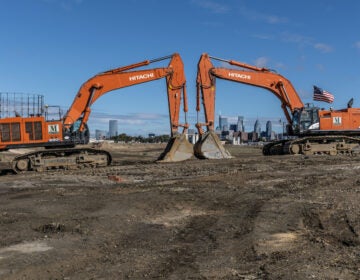Philly’s ‘unpredictable’ property tax assessments threatening new development, biz groups say
It’s no secret that successive rounds of property tax reassessments in Philadelphia are giving homeowners agita.

City Hall and the Center City skyline looking west from the roof of 1234 Market Street. (Emma Lee/WHYY)
This story originally appeared on PlanPhilly.
—
It’s no secret that successive rounds of property tax reassessments in Philadelphia are giving homeowners agita. But unpredictable reassessments may also be quietly eroding the viability of future development projects.
At least, so says Leo Addimando, the head of Philadelphia Building Industry Association, a developers consortium. The problem, in his words, isn’t solely the amount of the increases but rather that the uncertainty surrounding revaluations is spooking would-be investors.
“It’s becoming more and more a part of the conversation in the development community and the investment community in regards to the underwriting of real estate deals,” Addimando said. “It’s getting harder to sell real estate projects and commercial properties because of the uncertainty around what the taxes are going to be. Our out of town investors are throwing up their hands.”
For decades, real estate in the city was severely undervalued as corruption and bureaucratic obstacles ground the municipal reassessment process to a halt. Former Mayor Michael Nutter made fixing this issue a top priority, rebooting the city’s property tax division – today known as the Office of Property Assessment – and forcing a radical citywide reappraisal, known as the Actual Value Initiative, in 2013.
At that time, officials pledged to conduct annual citywide reassessments in order to bring the issue to final closure. But, in practice, Philadelphians have instead witnessed sporadic and sometimes seemingly inconsistent appraisals that have varied year to year.
In 2016, about 15 percent of parcels, mainly in gentrifying areas, saw between $15,000 and $30,000-worth of total property value shifted from from improvements to land – effectively eating away at a ten-year tax abatement enjoyed by many new properties. In 2017, the city appeared to shift focus towards increasing the assessments on many commercial properties, boosting values on 60,000 such properties by more than 50 percent – boosting collections by about $118 million. Finally, this year, assessors appeared to pivot again towards residential properties, with rates increasing by about 10.5 percent for the average single-family home and far more dramatically in some sections of the city – as much as 47 percent in fast developing neighborhoods like Strawberry Mansion and Brewerytown and 20 percent in sections of South Philadelphia.
Despite the magnitude of the changes and widespread public upset, the city has released few details about its computer-aided assessment efforts, declining to provide details on the formulas guiding the revaluations.
Addimando says that increases to property taxes present difficulties for developers already facing high labor and construction costs. But he says the unpredictability about the timing and focus of reassessments is particularly chilling for investors.
“You’re laying out so much money on day one, and then you’re waiting maybe 10 years for a payback. You’ve made some assumption about what your profit margin will be and as that margin narrows it affects the viability of every real estate project,” he said. “It’s the threat, the expectation and the unknown quantity of the increases…Uncertainty is the enemy of business.”
He said the damage was being felt even more acutely in the city’s already brittle office leasing market – which has been doubly hit by increases to the city’s related Use & Occupancy taxes. As office renters raise the value of a building simply by leasing out space, prospective tenants could become leery of properties that appeared to be on the cusp of reassessment.
“It’s weighing on office tenants. They’re taking a much harder look at office leases,” he said.
“As expenses go up over the years, the landlord has the option to pass those costs onto tenants. So, if you’re a smart tenant, you’ll look at when that building was last assessed.”
The city, for its part, asserted that it had, despite outward appearances, stuck to an annual reassessment schedule.
“[Addimando] is absolutely right that irregular assessments could cause uncertainty for property owners and thus indirectly hamper development. That is why the city…conducts annual citywide reassessments of all properties in Philadelphia,” said Mike Dunn, a spokesman for Mayor Jim Kenney. “Annual reassessments bring predictability that gives property owners greater ability to plan.”
But Addimando is not alone in his refusal to accept these assurances.
Paul Levy heads the Center City District, a downtown business improvement district that promotes development in the city’s core.
“For a variety of reasons, be they technical or due to insufficient staff, the OPA is not doing routine, annual reassessments. They have lawsuits pending against them for non-uniformity,” Levy said.
After an analysis of OPA reassessment efforts, Levy has come to believe the city may be quietly bundling together several years worth of reassessments together. He pointed to last year’s big jump in residential reassessments.
“Had it been done each year the average would have been about a 2.2 percent annual increase. But because it was not done for five years, and it’s so hugely uncertain it has this shock effect,” he said.
He also echoed many of the BIA concerns.
“You’re trying to underwrite these projects that are undergoing huge increase in costs. This type of uncertainty is unnerving to certain investors,” he said. “And these numbers have never worked on the office sector side. Those projects already only work in KOZs” – a reference to certain tax-free development zones.
Addimando suggested that if the issue is one of capacity for the OPA, that Philly emulate other counties and municipalities by instituting a more predictable, five-year citywide reassessment system.
Levy said transparency and consistency must be paramount if the city wants to continue attracting investment and jobs from private developers.
“Whether it’s every year, every three or five, predictability is the key,” he said.
“The herky jerk nature is what’s really unsettling about it now.”
WHYY is your source for fact-based, in-depth journalism and information. As a nonprofit organization, we rely on financial support from readers like you. Please give today.




